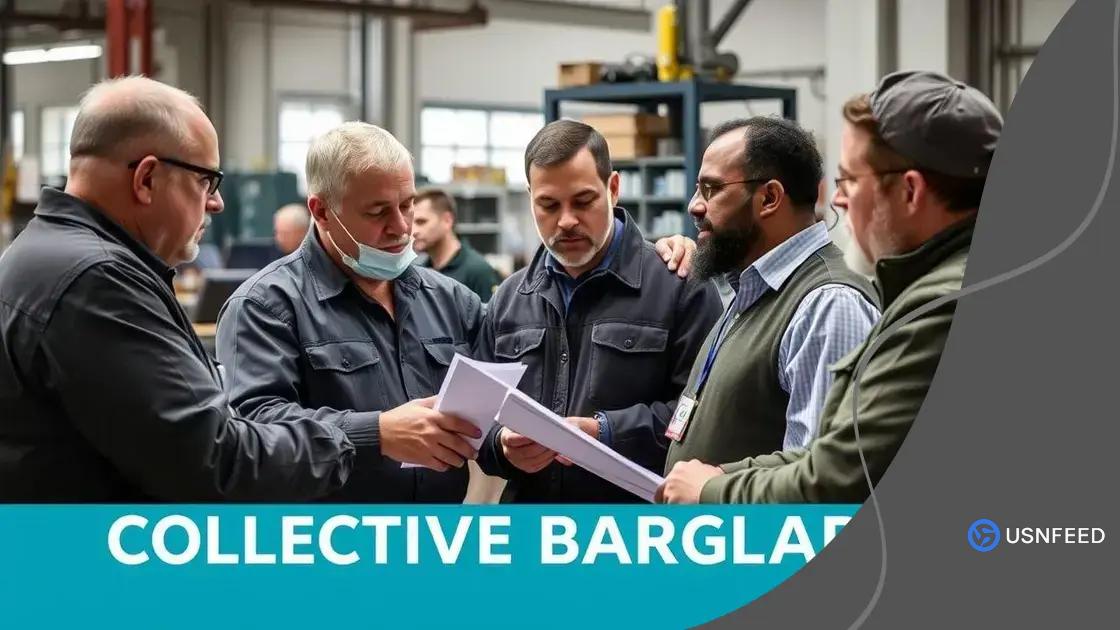Labor union activities and negotiations: why they matter

Labor union activities and negotiations play a crucial role in advocating for workers’ rights, ensuring fair wages, and improving working conditions in an evolving economy.
Labor union activities and negotiations are crucial for ensuring fair treatment of workers. Do you ever wonder how these efforts influence your workplace? Let’s dive in!
Understanding labor unions and their role
Understanding labor unions is essential for grasping their significance in today’s workforce. These organizations represent the collective interests of workers. They help negotiate better working conditions and advocate for employee rights.
Labor unions have a long history, originating in the early industrial era when workers sought to improve their circumstances. Today, they continue to play a vital role in various industries.
The Purpose of Labor Unions
Labor unions serve several purposes that benefit both employees and the economy. They aim to:
- Negotiate fair wages and benefits.
- Ensure safe working conditions.
- Protect workers from unfair treatment.
- Promote equality and diversity in the workplace.
These activities enhance the overall work environment, fostering respect and collaboration. When workers feel supported, they are more productive, contributing positively to their organizations.
How Unions Operate
Labor unions operate through a democratic process. Members elect leaders to represent their interests. These leaders then negotiate contracts with employers. The negotiation process often involves:
- Identifying key issues and demands.
- Engaging in discussions with management.
- Holding votes to approve agreements.
This structure ensures that workers have a say in decisions affecting their livelihoods. Furthermore, unions offer training and resources to help members develop professionally.
In summary, understanding labor unions and their role is crucial for recognizing the benefits they bring to workers and society. By advocating for fair treatment, they contribute to a healthier and more balanced workplace.
Key activities in labor union negotiations
Key activities in labor union negotiations are critical for achieving fair agreements between workers and employers. These activities ensure that the needs and rights of employees are respected throughout the process.
The bargaining process typically starts with unions gathering the concerns and demands of their members. This collective input is vital for creating a comprehensive list of priorities that represent the workforce effectively.
Engaging in Collective Bargaining
During the collective bargaining stage, both labor unions and employers come together to discuss potential agreements. This process includes:
- Presenting proposals that address wages, benefits, and working conditions.
- Negotiating terms that are acceptable to both parties.
- Utilizing skilled negotiators who understand labor law and workers’ rights.
Effective negotiation requires compromise and understanding. Both sides aim for a solution that benefits the workforce while also maintaining the employer’s ability to operate efficiently.
Research and Preparation
Preparation plays a key role in successful negotiations. Labor unions conduct thorough research to understand the current market conditions and industry standards. This knowledge helps outline realistic expectations during discussions. Important preparation activities include:
- Analyzing wage trends and benefits packages in comparable industries.
- Identifying potential obstacles and areas of contention.
- Training union representatives on negotiation tactics and strategies.
With proper preparation, unions can articulate their positions confidently and effectively advocate for their members. This diligence fosters an environment where negotiations can occur transparently and collaboratively.
Throughout the negotiation process, it is essential for both parties to communicate openly. This ongoing dialogue helps build trust and can lead to successful outcomes that improve working conditions for employees.
Impact of collective bargaining on employees

The impact of collective bargaining on employees is profound and far-reaching. Through collective bargaining, workers unite to negotiate better conditions, wages, and benefits with their employers. This process empowers employees, allowing their voices to be heard in the workplace.
When unions engage in collective bargaining, they often achieve significant improvements for their members. These negotiations can lead to higher wages, enhanced job security, and better work-life balance. Each of these aspects contributes to a more satisfied and productive workforce.
Wage Increases and Benefits
One of the most direct impacts of collective bargaining is the increase in wages for workers. Unions negotiate on behalf of their members to secure:
- Higher base pay compared to non-unionized workers.
- Improved health and retirement benefits.
- Job stability and protection against unjust dismissal.
For many employees, these enhancements make a significant difference in their quality of life and financial security. By banding together, workers can leverage their collective strength to negotiate terms that benefit everyone.
Improved Working Conditions
Collective bargaining also leads to safer and healthier work environments. Employees working under union contracts often experience:
- Stricter safety regulations.
- Access to necessary training and resources.
- Better support for mental health and wellness programs.
These improvements not only protect employees but also promote a culture of respect and teamwork within organizations. As unions fight for better conditions, they enhance employee morale and productivity, creating a more vibrant workplace.
The overall impact of collective bargaining extends beyond immediate benefits. It also fosters a sense of community among workers, promoting solidarity and mutual support. By recognizing the importance of employee rights, unions help establish a fairer labor market.
Challenges faced by labor unions today
Challenges faced by labor unions today are complex and multifaceted. While unions have historically fought for workers’ rights, they now encounter various obstacles that affect their ability to advocate effectively for their members.
One significant challenge is the changing landscape of the workforce. As more jobs become part-time or gig work, traditional union models struggle to adapt. Many gig workers do not have the same protections as full-time employees, making it difficult for unions to organize and represent them.
Political and Legal Pressures
Political and legal pressures also pose serious hurdles for unions. Recent laws and regulations in some regions have made it harder for unions to operate. For example:
- Right-to-work laws can reduce union membership.
- Restrictions on collective bargaining limit unions’ negotiation power.
- Political opposition from anti-union groups creates a hostile environment.
These factors contribute to a decline in union membership and influence, challenging the effectiveness of collective organizing.
Public Perception and Support
Public perception of unions plays a crucial role in their success. In some areas, a negative view of unions exists, often fueled by misinformation. Labor unions must actively work to reshape this view by:
- Highlighting their contributions to workplace safety and fair wages.
- Engaging with communities to build support.
- Promoting success stories that demonstrate their positive impact.
By bringing awareness to their achievements, unions can counter negative narratives and garner more public support.
In addition to external challenges, internal issues can also hinder unions. Leadership disputes, financial difficulties, and lack of member engagement can create obstacles that organizations must address. Strengthening communication and ensuring transparency are vital for maintaining member trust and participation.
The future of labor unions in a changing economy
The future of labor unions in a changing economy is both challenging and promising. As technology evolves and economies shift, unions must adapt to remain relevant and effective advocates for workers.
One major factor influencing the future of labor unions is the rise of technology and automation. Jobs are changing rapidly, and many traditional roles are disappearing. In response, unions are exploring how to represent workers in new industries and occupations. This includes understanding the needs of gig workers and those in non-traditional employment.
Embracing Technology
Labor unions are beginning to embrace technology to enhance their efforts. They use digital platforms for communication and organizing. Some of the key advancements include:
- Online membership drives to recruit new members.
- Virtual meetings to address member concerns efficiently.
- Using social media to raise awareness and build solidarity.
Technological adaptation allows unions to connect with younger workers, who may prefer digital communication over traditional methods.
Advocating for Workers’ Rights
Unions will continue to play a critical role in advocating for workers’ rights in this changing landscape. As economic models shift, labor unions are focusing on:
- Ensuring fair wages in gig and freelance work.
- Fighting for benefits and job security for non-traditional workers.
- Promoting legislative changes that support workers’ rights and protections.
This advocacy is essential in an economy where laws may not keep pace with changing job structures.
Unions are also aiming to develop partnerships with various organizations to broaden their influence. By collaborating with community groups and other advocates, they can work towards common goals that benefit all workers.
In summary, while the future of labor unions may be uncertain, their commitment to adapting to economic changes and advocating for workers ensures they will remain a vital part of the workforce landscape.
FAQ – Frequently Asked Questions about Labor Union Activities and Negotiations
What is the role of labor unions in today’s economy?
Labor unions advocate for workers’ rights, negotiate better wages, and ensure safe working conditions in a rapidly changing economy.
How do labor unions adapt to technological changes?
Unions are embracing technology by using digital tools for communication and organization, making it easier to connect with members.
What challenges do labor unions face?
Unions face challenges such as political pressures, changing job markets, and the need to represent gig workers effectively.
Why is collaboration important for labor unions?
Collaboration with other organizations helps unions broaden their influence and advocate more effectively for worker protections.